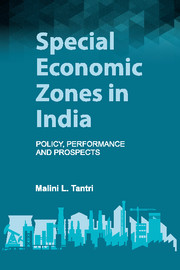Book contents
- Frontmatter
- Contents
- List of Tables, Figures, Charts and Maps
- Preface
- Acknowledgements
- Abbreviations
- 1 Introduction
- 2 Export Processing Zones to Special Economic Zones: Trajectories of Policymaking
- 3 China's Experience with Special Economic Zones under a Liberalized Regime – Highs and Lows
- 4 Performance of Special Economic Zones: Promises, Realizations and Paradoxes
- 5 An Assessment of the Fiscal Viability of Special Economic Zones
- 6 Special Economic Zones and the Question of Efficiency
- 7 Conclusions
- Bibliography
- Index
7 - Conclusions
Published online by Cambridge University Press: 13 September 2017
- Frontmatter
- Contents
- List of Tables, Figures, Charts and Maps
- Preface
- Acknowledgements
- Abbreviations
- 1 Introduction
- 2 Export Processing Zones to Special Economic Zones: Trajectories of Policymaking
- 3 China's Experience with Special Economic Zones under a Liberalized Regime – Highs and Lows
- 4 Performance of Special Economic Zones: Promises, Realizations and Paradoxes
- 5 An Assessment of the Fiscal Viability of Special Economic Zones
- 6 Special Economic Zones and the Question of Efficiency
- 7 Conclusions
- Bibliography
- Index
Summary
When it comes to evaluating an economic policy, three important elements need to be understood and examined carefully. First, the rationale underlying an economic policy, i.e., is there a clear understanding of why a particular policy is being put in place; do we have a clear idea of the expected benefits and associated negative impacts of a given policy; do we know the presence and experience of similar policies, if any, in other countries as well – have they been successful venture or flawed attempts and what factors underlies the outcome of such policies? Second, it is necessary to investigate how a policy is being implemented. Because, a policy may fulfil the first order condition, i.e., clarity underlying a policy but there can be flaws at the implementation. This is specifically so, because a policy is framed by the government but it is bureaucracy that implements the policy at different levels. Thus, the coordination or conflict between these two actors involved in the formulation and execution of a policy, respectively, does help to explain the third-order condition, i.e., evaluating a policy document, namely, performance. However, studies evaluating of a policy document largely concentrate on the performance aspect based on a few selected indicators without attempting to accommodate the underlying rationale and implementation part of it which actually influence the outcome of it, that is, a policy document is mostly evaluated on the basis of symptoms rather than the causal factors. An in-depth analysis of India's current policy on special economic zones within this framework helps us argue that SEZ policy in India has partially failed to meet the first-order condition, that is, the logic underlying the promotion of SEZs. In fact, policymakers have modelled India's policy on SEZs after China's model without giving a thought to the flaws inherent in China's SEZs policy. Further, it is important to note that the success of SEZs in China need not necessarily be attributed to China's ‘SEZ policy’ per se; rather various supportive mechanisms, both internal and external, are found to have played an important role in scripting this success story, thus indicating that SEZs cannot be expected to deliver an optimum performance under ceteris paribus condition; rather it requires a careful identification and execution of supportive factors, which may vary across countries, SEZs and/or between sectors within a given economy.
- Type
- Chapter
- Information
- Special Economic Zones in IndiaPolicy, Performance and Prospects, pp. 148 - 154Publisher: Cambridge University PressPrint publication year: 2016



